
Vegetable Harvesting


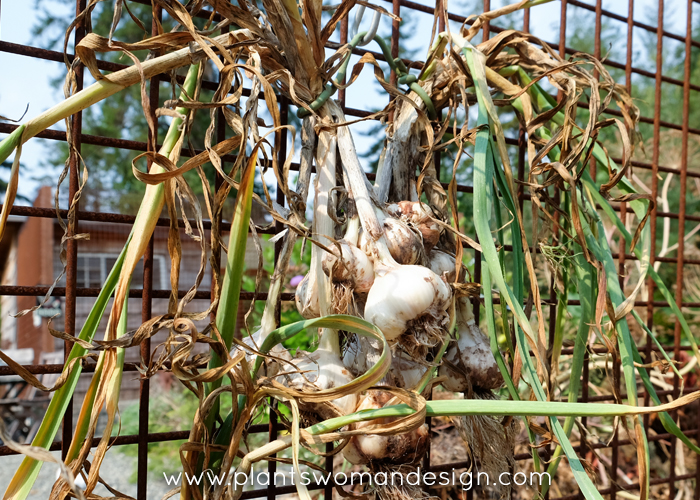






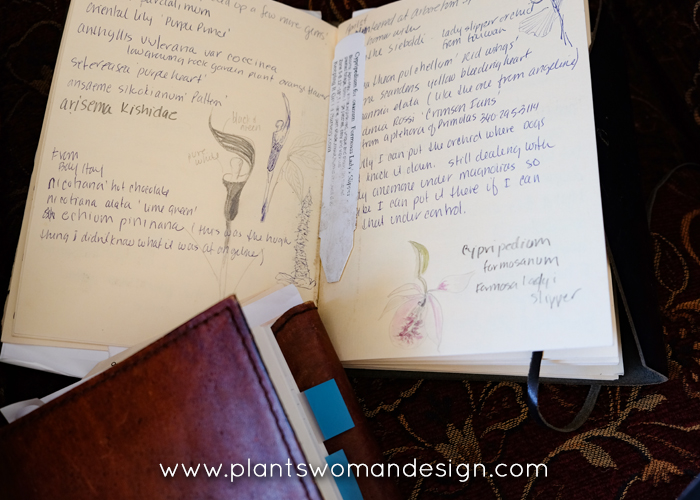








Ingredients
- 1½ cups white vinegar – distilled malt or white wine
- 1 tsp salt
- 4 tbsp raw sugar
- 1 tbsp chopped fresh dill
- 1 tbsp chopped fresh mint
- 1tsp coriander seeds
- 9 oz fresh cucamelons
- 1 fresh grape leaf or oak leaf
Instructions
Pour the vinegar into a bowl and add salt and sugar, then whisk until they have completely dissolved. Stir in the dill, mint and coriander seeds. Wash the cucamelons in water and pour into a sterilized jar. (Run the jars through the dishwasher and dry in a warm oven set to its lowest temperature.) Scrunch up the grape or oak leaf and place it on top of the cucamelons. The tannins in the leaf will slowly disperse outwards and help keep the fruit crisp. Pour the seasoned vinegar into the jar and seal tightly. Refrigerate for 2 weeks. The cucamelons will be pickled and ready to eat. Once opened, store in the refrigerator. They will keep up to 3 months, but most likely won’t last nearly that long! Yields about 1 quart.

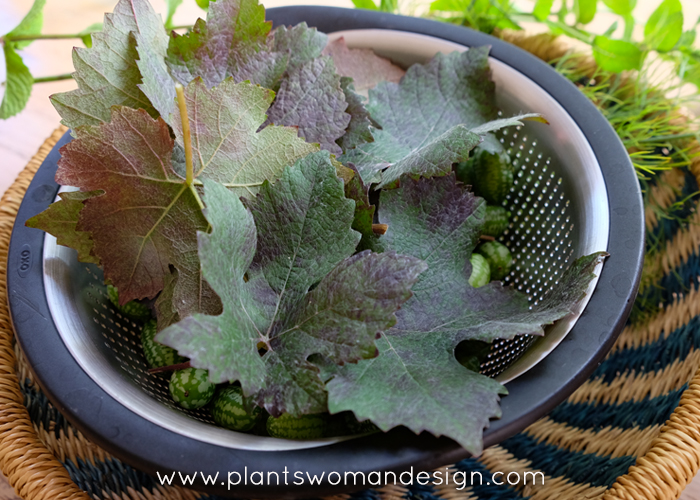


|
Days to Emerge: 7 – 21 Days |
|
Seed Depth: 1/4″ |
|
Seed Spacing: 3 seeds per mound |
|
Mound Spacing: 4′ |
|
Thinning: Not required |






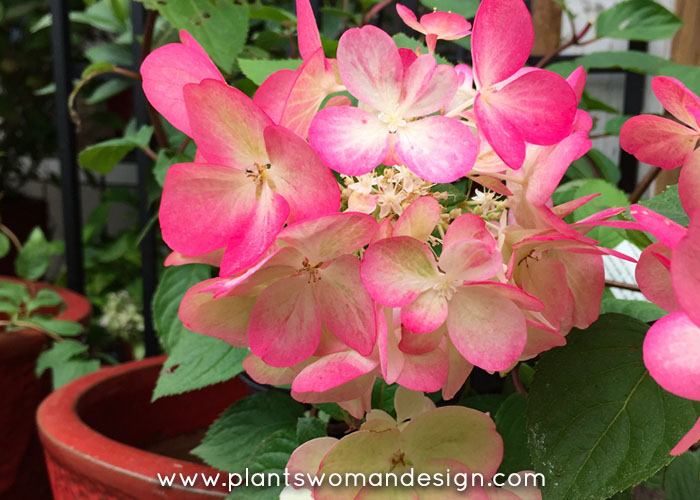



At best, I have a tenuous relationship with hydrangeas. Sometimes I love them and sometimes they seem like a boring old grandma shrub with little to bring to the garden. But just this week I was going through the upper shade garden and surprise, surprise there are many hydrangeas there. Did they sneak in while I wasn’t looking? Actually, I probably planted them as a test for my clients and there they are looking, I have to admit, fabulous.
When I’m thinking about using a new variety or type of plant in client gardens I test it out in my garden first so I know how it behaves. Hydrangeas are a long-time client favorite so it makes sense that there are some in my garden. I usually think of them as pretty blobs of color, good background, nice color but not really spectacular. However, I think anyone could agree to have these beauties in their garden.
When black stems became the rage several varieties of hydrangeas were introduced. Two of them are in my garden and while having the same stem they have different habits and color in the flower.


Hydrangea Zorro is a lace cap style that starts out fairly pinky blue and then changes shade to purple blue with lots of variations in color. Strong stems keep the flowers erect and impressive. This one is grown with very little direct sun but a bright open canopy.


Hydrangea Zebra is another black stemmed variety. It has stunning pure white blooms with that are a lace cap variety but the blooms are so closely packed they tend to look like the mop-head variety. It is grown with the same canopy and good shade. It likes moisture and good rich soil.

Walking on the dark side gives us the beautiful Hydrangea ‘Plum Passion’. The flowers are great but the real stunning part of this Hydrangea is the fuzzy leaf. The structure is big with a great background presence. I’ve grown it in a container by a front door and it maintains its leaves with a wandering long stemmed shape. This has been one of my favorite hydrangeas for years though most people would not recognize it as a hydrangea. Not a fan of direct sun, give this beauty shade and protection from strong winds.
Along with black stems, I do love lime colors in the garden. In a shaded area the bright lime really stands out.


Lemon daddy Hydrangea does that with very lime leaves. The mop-head blooms are white and stay true to color throughout the season. The leaf is electric lime with good variation in color within the leaf. Slugs occasionally eat the leaf so that can be a little discouraging as most hydrangeas don’t have a big slug problem. Lemon Daddy can take some morning sun but dislikes the hot afternoon sun. Good moisture is preferred but can take some drought too.


Two must haves are Lime light and Little lime, almost the same except for the size. Limelight can be 4 – 6 feet tall with blooms about 12” across while Little Lime stays more at the 2-3 foot height with blooms about 6” across. Both have tiny little blooms packed on the stems. It is a paniculata type with loose cone shaped blooms. These are grown in light shade with good moisture. They can take some drought but not hot afternoon sun.


I love the shape of paniculata style hydrangea. Fire and Ice is another paniculata style Hydrangea. This time instead of a green stem it has a good red stem. The contrast in the lime/white blooms and the red stems is very effective in a shade garden. The fall color tends towards red as the weather cools. Coming in at about 4 feet in the garden it makes a good background shrub for the back of a low border.


The oak leafed hydrangea ‘Jet Stream’ is a beautiful example of Hydrangea quercifolia with blooms held away from the main stem so they can be seen individually. The blooms have a tendency to be heavy so will sometimes droop when the bloom is especially large. As they get a little older they will have thicker stems so the blooms will stay up better. Jet Stream likes a little more sun and the thick oak shaped leaves will not burn so easy in the extra sun. They have a lovely pink tinge to the blooms as they fade in the fall.
Well as I write this I realize I really do like hydrangeas. In fact, I haven’t finished telling you all about the other ones in my garden. In my next post, I will share my favorite unusual varieties. Fragrance, deep velvet color and climbers are also here in my garden. Stay tuned!

Genus: Hydrangea
This plant produces gracefully arching branches and pyramidal clusters of white, then pink-tinged to dusky purple blossoms.
Noteworthy Characteristics: This is one of the most cold-hardy species. It may be grown as a single-stemmed specimen or as a multi-stemmed shrub.
Care: Grow in moist, but well-drained soil, in sun to partial shade. H. paniculata blooms on the current season’s wood; it may be cut back to a few buds to form a framework in spring to produce larger flowers, or allowed to grow with minimal pruning.
Not subject to frost damage because they bloom on new wood.
Overview

Genus: Hydrangea
This is one of the most widely recognized species of hydrangeas. It boasts a plentiful number of cultivars. The species is divided into two groups: the Hortensias (or “mopheads”) have globe-shaped flowers made up of large male flowers, and the Lacecaps have flattened flower heads, with central, female blossoms ringed in larger, male blossoms
Noteworthy Characteristics: Lacy, horizontal blossoms and large globes of flowers in rich colors. Many different colors have been developed but some can go through a color change with addition of soil additives. Lime soil will make some blooms pink while acid soil can push the blooms to blue.
Care: Grow in moist, but well-drained soil, in sun to partial shade. Provide shelter from drying winds. These hydrangeas flower on the previous season’s wood, and can be maintained by cutting back just to the first pair of buds beneath the old flower in spring.
Overview

Oakleaf hydrangeas originated along the sandy streams of the southeastern United States, and they are more drought tolerant than many other hydrangeas. Their matte green leaves are coarsely textured and deeply lobed, and in fall they turn red and purple. White flower heads form in spring, and as summer draws to a close they turn shades of pink, green, and ecru. -Nellie Neal, Regional Picks: Southeast, Fine Gardening issue #127
Care: Moist, well-drained soil.
Overview

As I continue to think about design in the vegetable garden I can’t help but think about the great design opportunities with the new varieties of Blueberries. The great thing about designing with blueberries is the year-round color and growth in the garden as well as the benefit of delicious berries in July. Many of these cultivars have a low chill factor so you can grow these in even warmer places and still have great fruit.
The cultivar ‘Sunshine Blue’ was introduced in 1979 but I didn’t know anything about it until about 10 years ago when it became more available in our area. I like using the cultivar ‘Top Hat’, which is a dwarf evergreen blueberry and difficult to find, whenever I could.

Vaccinium ‘Sunshine Blue’ has a slightly pointed leaf that is a medium blue green. With its fine, delicate foliage it can be used in a mixed bed, foundation planting or edging for a more formal bed. It can be sheared if you don’t care about the fruit and takes on a lovely blush purple color in the fall. In my zone 8 garden it is mostly evergreen with good production of fruit.
Plant Description
One of the best for mild-winter areas, a low-chill selection perfect for small gardens or large patio tubs. Blue-green foliage and showy pink to white flowers provide ornamental value, followed by an abundant crop of fruit. Self fruiting, but yields best when planted with another variety. Recommended winter chill: 150 hours. Semi-evergreen.

One of my new favorites is the ‘Bountiful Blue’ Blueberry. This one has a beautiful rounded leaf with good blue color. They tend to have a coarser texture than the ‘Sunshine Blue’ but boast prolific foliage and sturdy structure. These look wonderful in a natural landscapes with many types of ornamentals. Japanese, northwest and cottage styles all benefit from these great plants.
Plant Description
An award winning variety with the bluest foliage of all! Pink-blushed flowers produce a big crop of large, sweet, juicy berries on a compact, mounded shrub. Perfect for hedging or planting in large tubs. Self-fertile, though planting another variety may yield a more prolific harvest. Needs only 150-200 winter chill hours. Semi-evergreen in mild climates.
These are also candidates for container production. I have several clients with large pots in their gardens with blueberries. ‘Pink Lemonade’ and ‘Peach Sorbet’ work particularly well for containers.
For the best fruit production give the plants good full sun and good moisture. They are happiest under irrigation. You could put them in part shade but expect lower fruit production.
Here is a video from Nicolas Statton on how to prune the evergreen varieties for fruit production. These are available from the growers at Monrovia. Have a look at that while I go make blueberry muffins.

We have all seen great pictures and even visited designed vegetable gardens. Some great potager, or kitchen, gardens are famous for their beautiful symmetrical designs. My kitchen garden sports simple raised beds in a fairly linear design. I’m planning on revamping the configuration of the beds next year. I’ve found that the long beds that are wide (6 feet) are easy to plant but hard to harvest. Stepping into the bed is not optimal and sometimes there are such a tangle of plants in the middle the harvest is lost. That, however, does not keep me from planning some good color combinations in the veg garden.

This year I experimented with purple. I already had purple artichokes from last year and they are lovely again this year. Not only do they lend great sculptural qualities but their color is amazing. A combination of purple and green that holds it color even when dried for fall decoration.

Purple peas are growing, rambling and producing the loveliest pea pods. The peas inside are green and flavor is amazing. The pods are too tough to eat but there are so many pods that the harvest is good for shelled peas. This is a tendril pea so the strange flower like tendrils were odd looking for me. I did pick some and did a quick sauté to go with halibut cheek. Pretty great!
70 days A marvelous innovation in sugar snap pea breeding from Dr. Alan Kapuler, the first ever purple podded sugar snap pea! We love the dusty purple blue pods that really pop in a sea of green foliage. … The flavor is perfect, not too sweet, with a great snap!


Purple broccoli is another purple plant that has a wonderful color with contrasting dusty sage green leaves. The flavor is great and it produces well. Baby leaves can be used in salad as well. My plant came from the nursery in a pack and unfortunately, they don’t list the seed variety on the plants. I have tried the purple sprouting kind before and it is best in the fall and winter. It over wintered and produced small broccoli pieces all winter.

In my blog post, Easter Gift Of Plants, we planted purple carrots at my grand daughter, Kayla’s, request. They’ve done well and are great to eat, beautiful to look at in salads. (that garden is doing quite well!)

Of course, you can’t help but love the purple blue color of blueberries in the garden. The fresh lovely blush or purple/blue as it becomes deep blue is so beautiful. In the early morning with dew they become a reflection of the sky and the green leaves around them. These are an unknown variety rescued from a garden under construction. The border around the fruit beds are Vaccinium Bountiful Blue, an evergreen blueberry that produces great fruit and is beautiful all year round. Fine Gardening has this to say about it.
An award winning variety with the bluest foliage of all! Pink-blushed flowers produce a large crop of large, sweet, juicy berries on a compact, mounded shrub. Perfect for massing in the landscape or featuring in large tubs. Self fertile, though planting another variety may yield a more prolific harvest. Requires just 150-200 winter chill hours. Semi-evergreen in mild climates.
Care: Provide rich, acidic, well-drained soil. Water regularly during the growing season to maintain a deep, extensive root system. In extremely hot and arid summer areas, best with some shelter from harsh, reflected afternoon sun. Before new growth begins, prune off twiggy growth, leaving only main stems to prevent overbearing.
Read more: http://www.finegardening.com/bountiful-blue-blueberry-vaccinium-corymbosum#ixzz4mp1pdVz0
Follow us: @finegardening on Twitter | FineGardeningMagazine on Facebook
There are two more purple things in the garden that are not quite ready yet. Some seed samples from Burpee seed included a Depurple cauliflower hybrid. The plants are doing well but not ready for a picture yet. Burpee seed description.
Ravishing new purple cauliflower with buttery-sweet flavor.
Full Description
In foodie land, cauliflower is now a thing—a flavorful, delicious thing—inspiring culinary rapture, with food writers reaching for apt superlatives. ‘Depurple’, a ravishing new purple cauliflower, is a trendsetter with delectably textured, buttery-sweet, nuttily nuanced lavender-blue florets. Adds magical color and savory rich flavor served fresh, broiled, sautéed; as fritters, or in a summery cool purple soup. The distinctive color comes from anthocyanins, the antioxidants found in red wine, so purple cauliflower is more nutritious too. To retain the color, sprinkle with vinegar or lemon juice before steaming, roasting, or sautéing. A must-have selection for 2017.
80 days to maturity, sun, plant in fall or spring.
I also picked up some purple brussel sprout seeds from Territorial seeds. The Rubine Brussel Sprout seeds are in the house now. They are 4 leaves and will be ready to go out in about two weeks. 85 days. An heirloom variety not often seen in the garden. Rubine offers up a bountiful harvest of gorgeous 1-1 1/2 inch purple-red sprouts that are full of wonderfully rich old-time flavor. A striking addition to any vegetable patch and a gourmet special for your table. Grows to 24 inches and performs best when planted early.
I’ll keep you updated on progress and will take pictures of the varieties as they continue to produce. Many of the seeds are available for fall planting so it is not too late to start gardening in color!
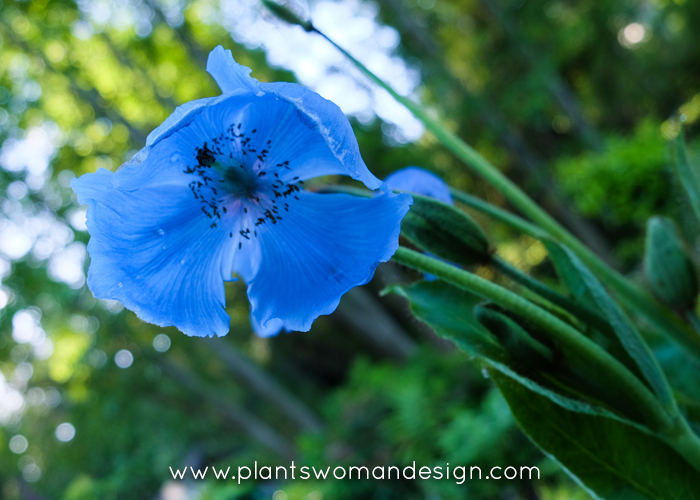
Summer is creeping up slowly. Hard to imagine that the 15th of June was raining, blowing, and 52. Sometimes you have to just wait without railing against the weather and just enjoy.
Some things were very unhappy in the garden. The tomatoes think they got transplanted to Siberia. Basil seeds refused to budge from the soil. Clematis starts remained at 1 inch for the past month, and begonias only had two small leaves showing in each corm.
But other things loved the cool weather. The peas are producing and lush. Starts in the green house are patiently gaining girth and the rest of the garden was full of surprises.

The Himalayan blue Poppy – meconopsis ‘Lingholm’ is thriving in my garden. The incredible blue color is hard to imagine, even in person. Once considered a myth, I planted these spectacular flowers—which are native to the high elevations of the Himalayan Mountains—in my garden this year. One was planted last fall and is a little bigger than the ones I planted this spring. This cultivar, ‘Lingholm’, produces large flowers that are four-inches in diameter on average. The substantial petals are a mesmerizing deep sky blue color. When under stress, the plant may show a tint of mauve. Having grown Meconopsis betonicifolia once before (it lasted 2 years before it died) I was happy to try this easier version. The myth said to pinch off flowers for 2 years to make a stronger plant. I did it to one but couldn’t resist letting the other one bloom. They both died the same year. The ‘lingholm’ strain is easier to grow and is a more reliable perennial. Happy in my cold garden this May.

This dogwood (Cornus ‘Milky Way’) was transplanted from a client’s garden. It was unhappy down by the beach where I had originally planted it. With only three good branches, much of it was dead. I replaced it with a maple that was happier by the beach. Last year it was just barely alive, but this year it is very happy. The cool weather and lots of rain have made it so happy. The blooms lasted for two months and hung on despite the stormy winds.

Iris are also showing themselves in the garden. This little charmer is Iris ‘Leopard Print’. Although it is small it stops you in your tracks because of it’s unusual coloring. It needs a little slug protection but can hold it’s own place in the garden.


The spring combinations of Sambucus ‘lemony lace’, purple pansies, Weigelia ‘Dark Horse’, Nandina ‘Firepower’, and sparkle of Carex elata ‘aurea’ are fresh and vibrant against the gray skies. The extra moisture has insured its lush foliage is undamaged by too much sun. I will add Nicotiana later in the year for fragrance when the pansies are fading.
Walking through the garden is very necessary on gloomy days. I remember when I first started back to school for Horticulture. Walking to class through the arboretum I saw that spring happens one day at a time. Not in gulps and leaps but slowly. Every day there is something else to see that wasn’t there the day before. This is true in your garden too!